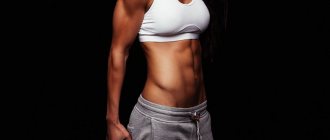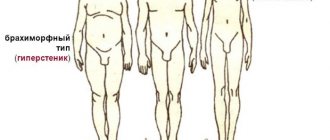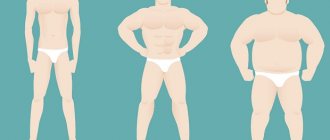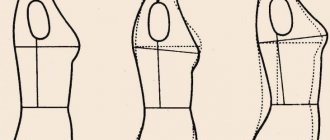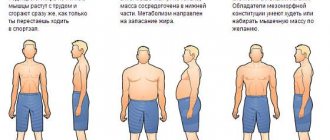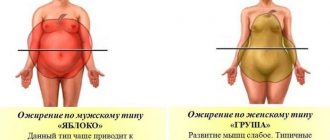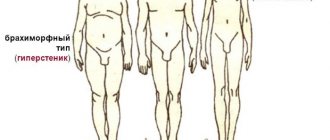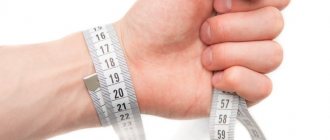Based on bone structure, weight gain patterns, and problem areas, there are traditionally three body types. To determine which of them your figure belongs to, just look carefully in the mirror and take basic measurements. It cannot be said that any of these types is more beautiful. You can like all of them equally; it is important to choose the right image and clothes, taking into account the characteristics of the category. With a mixed type, you should focus on the prevailing indicators.
Girls' body types, distinctive features
Silhouettes can be slender, stronger or voluminous. Body composition depends on genetic data, the distribution of fat and muscle mass, as well as the metabolic process.
If you know exactly what type of figure a particular girl has, then you can choose beautiful clothes for her that will hide flaws and emphasize the positive features of her physique. This knowledge will help you correct problem areas if you choose the appropriate training style. Each type of female physique has characteristic features. Further in the article you can read a detailed description of each type of figure separately.
Type X (“hourglass”)
What does the silhouette of a girl with this body type look like:
- The hips and shoulders are the same width. The difference may be slight, from 2 to 5 cm.
- The waist is clearly visible, even if the woman has weight lines.
- With a rapid increase in fat mass, it spreads evenly throughout the body.
- The body and leg length are proportional.
- Breasts are large or medium in size.
This body structure is often called the sexiest, because the volumes of the chest and hips are the same, and the waist always remains narrow. This silhouette visually fits the 90x60x90 standards, even if these numbers are higher or lower.
Such forms were especially popular between the 18th and 19th centuries in England and France. Women, wanting to have an ideal figure, tightened their waists with a tight corset to such an extent that they sometimes lost consciousness from lack of oxygen and blood circulation to the upper body.
Type A (“pear”)
What shape does the “pear” silhouette have:
- The hips are much wider than the shoulders.
- The waist is clearly visible in slender girls. In obese women, this line has blurred boundaries.
- When a girl gains excess weight, fat tissue is not evenly distributed throughout the body. Most of it is deposited in the hips, and the arms, shoulders and chest gain weight slightly. Often the lower and upper parts of the body differ by 1-2 sizes, which causes inconvenience when choosing suits and dresses.
- Breasts are small or medium in size.
For those with this body type, it is important to pay attention to their posture. Slouching visually makes the abdominal area fuller.
Currently, this body type is considered desirable for many girls. They make considerable efforts to increase the volume of the gluteal muscles and make them round.
Type V (triangle)
This type of figure is the opposite of the previous one. What are the features of the “triangle”:
- Narrow hips and broad shoulders.
- The chest is lush, the upper body looks strong and voluminous.
- The waist is poorly defined, even in slender women the sides are almost even, without curves.
- When you gain excess weight, fat tissue is primarily deposited on the shoulders, chest and back.
Girls with this body type should not emphasize the chest area with high-waisted dresses. They greatly distort the silhouette and add visual volume to the abdominal area. They should also give up wide belts, since these accessories “separate” the upper and lower parts of the body, and the disproportion of the figure becomes even more noticeable.
Type H (“rectangle”)
Distinctive features of this physique:
- The width of the hips and shoulders is the same or has a slight difference.
- The waistline is not pronounced, just like a “triangle”.
- In general, the upper body is rectangular in shape. With rapid weight gain, the stomach becomes fuller and the “ears” on the sides grow.
Slender women of this body type have angular and elongated silhouettes, similar to the outline of a teenager. They have to wear bulky clothes to appear more feminine. Figure flaws are well hidden by fluffy dresses made of flowing fabrics. Also, in order to visually increase the width of the body, designers advise thin women to wear clothes in light shades.
Type O (“apple”)
What does a girl with this body type look like:
- The width of the shoulders and hips differs slightly.
- The waist is straight, without bends, poorly defined.
- When you gain excess weight, your figure acquires a rounded silhouette. Fat is deposited evenly on all parts of the body. Extra pounds are especially noticeable on the stomach, arms and hips.
Women of this body type have a harder time keeping their bodies in good shape. As a rule, they tend to be overweight. Girls with apple shapes are not recommended to wear tight clothes, because they will highlight all the imperfections of the body.
Girls' figures (types can be determined by different characteristics) differ from each other due to the active work of different glands in the body. This classification is called metabolic.
There are 4 main body types:
- lymphatic;
- thyroid;
- ovarian;
- adrenal.
Glands located in different parts of the body are responsible for the distribution of fat and muscle mass. The pituitary gland is located in the area between the eyebrows, the thyroid gland is located in the throat area. The ovaries are located in the pelvic area, and the adrenal glands, as the name suggests, are located above the kidneys.
Lymphatic
A figure of this type acquires characteristic features due to the active work of the pituitary gland. The body shape is similar to the apple type. The hips and chest are the same in width, the waist is poorly defined, and the limbs are shortened. Metabolism is slow. A lot of fluid is retained in the tissues, and a woman easily gains excess weight.
As a rule, the tendency to be overweight manifests itself in childhood and adolescence.
The muscular frame of such girls is weak and poorly developed, which makes it harder for them to play sports. Professional fitness trainers are aware of this feature and recommend that women with this body type pay attention to cardio exercises, such as dancing or running.
Thyroid
The shape of the figure is similar to a “triangle”. These girls have a good thyroid gland. Usually this type is not characterized by completeness. The physique appears normal, sometimes thin. Narrow shoulders, long arms, legs and an elongated body resemble the outline of a teenager.
Muscle mass is easily gained, and extra pounds are lost, with the right training system. With age, the metabolic rate decreases somewhat and women over 35 years old have to carefully monitor their body condition.
Ovarian
In women of this body type, the ovaries work well. Their shapes resemble an hourglass or a pear. They have large or medium-sized breasts, voluminous hips and blurred waist lines.
Such girls tend to be overweight, but when they gain extra pounds, their body looks proportional. Fat is mainly deposited on the hips, buttocks and chest. The waist remains clearly defined. Wide hips allow you to bear and give birth to children without complications.
Adrenal
This body type is often called masculine. In terms of silhouette, the body shapes of such girls resemble a “rectangle”. They have wide, massive shoulders, and their hips are much narrower. The gland that is responsible for the distribution of fat and muscle mass is the adrenal glands. The muscular corset of such women is well developed. Adipose tissue forms slowly and extra pounds quickly disappear if you make a little effort. Skirts with flounces and dresses with fluffy hems help make your figure visually proportional.
Training for hips and buttocks to correct the pear shape
Exercises for a pear figure should be aimed at working out problem areas. A properly selected complex will help get rid of fat deposits.
Squats
Place your feet shoulder-width apart and keep your back straight. Squat down slowly, moving your pelvis back. Your knees should be bent at a 90-degree angle, but not beyond your toes. In this position, the muscles of the thighs and buttocks are tensed, and the load on the knee joints is reduced. Do 3 sets of 15-20 reps.
Do squats to correct the shape of the pear.
Lunges
This exercise helps make your thighs more defined:
- Stand straight with your feet shoulder-width apart.
- Lunge forward with your left leg, shifting your body weight to that limb. The right leg bends slightly at the knee and remains motionless.
- Return to the starting position.
Gluteal bridge
This exercise helps to work the muscles of the buttocks:
- Lie on your back, bend your knees.
- Lift your pelvis up, while trying to tighten your buttocks as much as possible. The neck and shoulders remain on the floor.
- Lower your pelvis to the floor and repeat the exercise again.
The glute bridge works the muscles of the buttocks.
Swing your legs
This movement is aimed at working the thigh muscles:
- Stand up straight, keep your back straight.
- Inhaling, lift your leg forward and up, being careful not to bend your knee. Freeze in this position for a few seconds and lower your leg.
- Repeat the exercise on the other limb.
Step ups
For this exercise you will need a low chair or bench:
- Stand on a chair with your right foot.
- As you exhale, lift your body up and stand on the chair with both feet.
- Return to the starting position.
Step ups are very effective.
Constitutional classification of female body types depending on bone size
The figures of girls (the body types of overweight women can be similar in appearance) can be classified according to the thickness of the bones. Professor Chernorutsky came up with the idea of distinguishing body types in this way.
He identified 3 main types:
- asthenic;
- normosthenic;
- hypersthenic.
It should be remembered that the physique of some girls may differ from the standard description. Much depends on eating habits, physical activity and lifestyle in general.
Asthenics
These are girls with thin and light bones.
Characteristic signs of asthenic:
- thinness;
- long limbs;
- elongated body;
- angular facial features;
- narrow shoulders and hips;
- thin neck;
- small breasts.
On average, the height of such women is above 170 cm. The muscular frame is weak and poorly developed. The waistline has blurred boundaries or subtle curves. Such girls are not prone to being overweight; they have a good metabolism. They do not tolerate heavy physical work well, but generally remain active and love to move.
Asthenics often have problems with blood pressure. Usually it is below normal. They also often have a lack of hemoglobin and problems with the spinal column (curvature, osteochondrosis, pinched nerves). The joints can be hypermobile, which is why girls of this type have good plasticity.
Doctors recommend that asthenics develop those qualities that they lack, for example, strength and endurance. General strengthening exercises, swimming and aerobics will help with this. It is also important for them to eat right and consume a lot of protein (30% of the daily diet) and carbohydrates (50%).
Normosthenics
These women have normal bone thickness.
What does the silhouette of a normosthenic look like:
- slender and long legs;
- well defined waist;
- the width of the shoulders and hips has a slight difference, usually the hips are slightly wider;
- medium size breasts;
- proportional body.
The height of girls of this type is average or slightly lower. The muscles are well developed, so such women are more resilient than asthenics. They can endure heavy physical work more easily. When you gain excess weight, fat is distributed evenly throughout the body. Normosthenics easily lose unnecessary pounds and quickly build muscle mass in their youth, but with age it becomes more difficult to keep their body in good shape.
Nutritionists advise women of this body type to consume less fat (15% of the daily diet). To keep your body in good condition, you can play basketball, swimming or tennis. This will help strengthen the muscle corset even more, as well as develop plasticity.
Hypersthenics
This type of person has wide and massive bones.
What the forms of hypersthenics look like:
- short arms and legs;
- broad shoulders;
- massive chest;
- flat gluteal muscles;
- strong and wide calves;
- undefined waist.
The height of such women is below 165 cm. Metabolism is slow, so fluid accumulates in the tissues and there is a tendency to gain excess weight. The muscle corset is weak, but it can be strengthened by choosing a good training system. Such women are hardy and tolerate hard physical labor well. They also give birth to large children (more than 3 kg) more easily due to the special structure of the pelvis.
Hypersthenics often suffer from cardiovascular diseases, arteritis and spinal problems. Doctors recommend that they carefully monitor their health and eat right. It is not recommended to eat a lot of fat (more than 10% of the daily value). It is better to give preference to slow carbohydrates and protein foods (30% of the daily diet).
Girls of this physique need to develop flexibility and plasticity. Fitness trainers advise paying attention to activities such as yoga, aerobics and martial arts. The latter option is suitable for hypersthenics because they are considered the most resilient of the other metabolic body types.
Rules for creating a diet
The condition of the figure depends 70% on the quality of nutrition.
If you are going to get rid of extra pounds or maintain your weight within normal limits, you need to follow simple rules:
- Eat small portions, dividing the daily amount of food into 5-6 meals.
- Make a food consumption schedule. Over time, the body will get used to secreting gastric juice at one time or another, and the feeling of hunger between meals will disappear.
- Monitor your drinking regime. You need to drink about 2 liters of clean water per day.
Recommended Products
The basis of the diet should be:
It is recommended to eat meat and fish.
- lean varieties of meat and fish that will provide the body with proteins, phosphorus, and unsaturated fatty acids;
- eggs;
- seaweed and seafood;
- vegetables (except potatoes) raw, boiled and baked;
- unsweetened fruits and berries;
- leafy greens;
- fermented milk products (low-fat kefir, cottage cheese, yogurt, cheese);
- dried fruits;rekmen
- nuts;
- porridge (buckwheat, bulgur, oatmeal, corn grits).
Foods to Avoid
You will have to give up:
Sweet foods should be excluded.
- sugar and any sweet foods (they contribute to the formation of cellulite);
- pastries and white bread;
- salt;
- fatty and fried foods;
- smoked meats;
- canned food;
- fast food;
- sausages;
- legumes;
- alcohol;
- carbonated drinks.
National characteristics of the female figure
Girls' figures (body types do not always depend on race) can be divided into types that are characteristic of certain nationalities. The table shows examples of the main types of female forms.
| Type name | Characteristics |
| Asiatic | Angular, teenage contours. Narrow hips and shoulders. Small breasts, thin arms and legs. Well defined waist. |
| European | Proportional body. Slender legs, lush breasts. Short but graceful neck. The waistline is weakly defined. |
| African | Wide hips, narrow shoulders. Fuzzy waistline. Lush breasts, short legs. There is a tendency to be overweight. |
| Oriental | Well defined waist, slender long legs. The length of the lower and upper body is proportional. Well developed muscular skeleton. |
| Slavic | High growth. Broad shoulders and hips. The waist has blurred boundaries. Medium to large breasts. Short neck, but long limbs. |
Mestizo girls have different silhouette shapes. Their body type is passed on to them from the parent whose genes turned out to be stronger.
Salon treatments for weight loss
The fight against excess weight is a long and complex process, so you should not give up cosmetic procedures.
The salon may recommend methods such as:
- cavitation (during a session, fat deposits are exposed to ultrasonic waves);
- cryotherapy (subcutaneous fat tissue is frozen, destroyed, and then removed from the body naturally);
- ozone therapy;
- acupuncture (during the procedure, a specialist acts on the active points of the human body, which allows activating metabolism).
Cavitation is performed without surgery.
All these procedures allow you to target problem areas without affecting other parts of the body.
How to determine your body type yourself?
To understand what type of figure a girl is, she needs to take a good look at herself in the mirror. You can ask your friend to take a few full-length photos in a swimsuit to make it more convenient.
What else needs to be done:
- Measure your waist, hips and chest. Compare them.
- Measure the length of the lower body and upper body.
- Determine your strengths and weaknesses (endurance, tendency to be overweight, flexibility, etc.).
Based on these points, conclusions can already be drawn. You also need to take a close look at the photo (front and back views). Visually, you can notice that the upper part of the body resembles some kind of geometric figure, for example, a “rectangle” or an “hourglass”. If this is so, then the type of figure corresponds to the name.
Cardio exercises for the pear
Strength loads help make the body more resilient, build muscle mass, and develop relief. To get rid of excess weight, you need cardio training, during which fat deposits are actively burned.
It is not necessary to visit a fitness center: some exercises can be done at home.
Regular jogging, jumping on a trampoline and skipping rope, and roller skating will have a positive effect on your figure. Swimming, dancing and other activities that increase your heart rate are suitable.
How to determine your body type based on your wrist?
Girls' figures (the types of some silhouettes are more difficult to recognize because they are mixed) can be determined by the volume of the wrist. For this you will need a measuring tape. It doesn't need to be pulled too hard. The arm is measured freely without squeezing the muscles. It is better to ask another person for help, since it is difficult to do it on your own.
A wrist volume of less than 15 cm indicates an asthenic body structure. The bones are thin, the palm is small, and the fingers are long and graceful.
A wrist circumference greater than 16 cm indicates that a woman belongs to a normosthenic type. Bones of normal width. The palm is long and wide. The fingers are of medium length, the bones on the back of the hand are clearly visible.
If the measurement result exceeds 18 cm, then the bones of such a woman are heavy and wide. This means that she belongs to the group of hypersthenics. The palms of such girls are wide, the fingers are short and full.
Photos of people with asthenic physique
Thinness, thin dry skin, pallor, tall stature, long arms - this is a typical description of an asthenic. Vulnerable, taciturn, and at the same time resistant to stress, restrained from showing emotions, they differ from other types in many ways. By appearance, photographs of people with an asthenic type of body structure will help to accurately determine this type of constitution. Characteristic features - from a narrow chest to delicate facial features - appear clearly, so others do not associate people of this physique with good health.
The human body has its own unique characteristics - weight, shape, proportions. It is customary to distinguish the main body types. Although every person has it at the genetic level, it can be corrected in childhood. The structure of the body and its features should be taken into account when selecting diets and training.
Which female figure is the most attractive?
There is no one-word answer to this question, because standards for the female form and beauty in general are constantly changing. For example, figurines preserved from the Stone Age have curvaceous shapes. Women of those times were considered beautiful if they had a protruding belly, large buttocks and muscular thighs.
In the era of Ancient Rome, women of the “rectangular” type, but stockier, were considered the standard of beauty. They were supposed to have broad shoulders and a massive chest. The pelvis remained narrow and the waistline was poorly defined.
In the 16th century, plump silhouettes with round bellies, wide hips and ample breasts again became attractive. This trend continued until the 19th century. Then the standard female figure became noticeably smaller and slimmer.
In the early 1990s, “rectangle” girls were in fashion. Many men were attracted to thin women with teenage curves. Closer to 2005, society's preferences changed again. Now people paid more attention to girls with beautiful, athletic proportions.
10 years ago, all representatives of the fairer sex dreamed of having a “triangular” body type. At that time, a healthy lifestyle was in fashion, and well-developed muscles were valued. The girls tried to pump up their six-pack abs. They wanted to look stocky, tough and athletic.
Nowadays the “pear” figure has become popular. Girls spend a lot of time working on their gluteal muscles. They should be wider than the chest, rounded and clearly visible.
Girls have different types of figures and it is impossible to decide exactly what is beautiful and what is not. Much depends on genetic data, lifestyle and physical activity. In addition, body shapes distinguish women from each other, and knowing their body type, each will be able to emphasize their individuality even more by choosing the right clothes.
Reviews and results
Marina, 23 years old, Tyumen: “For many years, my figure was a source of emotional complexes.
Therefore, I revised my diet, gave up sweets, started running in the morning, and did body wraps 2 times a week. In 2 months I lost 6 kg, changed my wardrobe and feel beautiful.” Alina, 35 years old, Moscow: “After giving birth, I gained 15 kg. With the help of proper nutrition and Latin American dance lessons, I lost 10 kg. But the belly still remained round. They helped solve this problem at the beauty salon with a couple of cryotherapy sessions.”
Normosthenik ecg
plastic surgeon, oncologist, doctor of the highest category
Electronic periodical: Vladmedicina.ru medical portal of the Primorsky Territory
Founder and publisher: Vladmedicina.ru LLC
Address of the founder, publisher and editorial office: Vladivostok, st. Khabarovskaya, 12. Editor-in-Chief: Mosolov K.V. tel.: , (JavaScript must be enabled to display the address)
Registered with the Federal Service for Supervision of Communications, Information Technologies and Mass Communications, certificate EL No. FS6.
All rights reserved. When completely or partially copying information from this resource, a link to the site is required.
The information provided on the site is for general information only and cannot replace actual medical advice.
There are contraindications. Be sure to consult a specialist!
